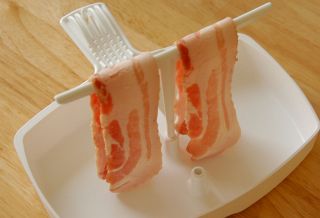Cooking Tests: Bacon (Part II)
When I posted the first Bacon Cooking Test (October 2004), I knew that I would have to continue to test different ways to cook bacon. I was so sure that a second article would follow that I named labeled that first article as "Part I". Over half a year later, I've finally gotten around to writing up my latest experiments with cooking bacon.

13 Comments:
I have found that slow cooking
(baking) meat consistently produces the best flavor. This even in steaks normally grilled.
I bake with no condiments and no
wire rack. More like a bbq with no
sauce. Sauces can be added when eating, and varied. A variac on a toaster oven or contact grill and a good thermometer take the guess work out and more even heat.
Here is the inexpensive
20 amp VARIAC I use.
http://store.yahoo.com/webtronics/varacouttran.html
Cooking bacon, or any fatty food like duck breast for example, requires a slightly differant treatment than most meats. It's best to start by placing the meat, fat side down, in a cold and dry pan. Then the stove is turned to high until the fat begins to sizzle. At this point the heat is turned to medium high until done. This approach allows the fat to gradually render, producing a superior product.
Is there any meat on the bacon you get in america? It is totally different to what we call bacon in Australia
re: Australian bacon?
I'm not familiar with the bacon that is sold/served in Australia. American bacon is cut from the belly, cured or smoked. The fat content is about 50% (eye-balling it, not actually measured). Generally streaks and clumps of meat are surrounded by ample areas of fats.
Canadian bacon is cut from the loin and in comparison is not fatty at all. It has a different texture and taste (almost like ham) when compared to American bacon.
Perhaps the bacon sold in Australia is like Canadian bacon?
As I understand it, what we in America call bacon is called "streaky bacon" elsewhere in the anglosphere.
the most commonly available form of bacon here in the antipodes is known as "middle rasher bacon" which comprises the streaky/fatty bit and a generous portion of meat at one end crowned with a small layer of fat. the cut i believe, is from the middle to back portion of the animal.
watch Good Eats on food network
A B says put your bacon in a cold oven and pre heat to 400 i leave it in about 12 minutes and i'v tired most of the other methods and find this to be successful for flavor plus i even just use my toaster oven if all i want is a little and ajust the time to suit your tastes
In Canada, bacon is the same stuff that Americans eat. "Canadian bacon" is usually called "back bacon" here. My dad likes back bacon coated with peameal.
My Grandfather always has bacon with the "rind" on at his house in SW Arkansas. I'm sure that he bought it from the local butcher. It was always an exotic treat.
Bacon and a nap! I know what I'm doing on sundays.
Ah - I can't vouch for it's flavour in comparison to pan-fried or other methods, as it has been many years since I've sampled it this way at my grandparents - but in the microwave, an old newspaper section folded in half withpaper towels in the middle - bacon strips cooked there... just another method to chew on.
I really enjoy your site, keep up the good work!
Post a Comment
<< Home